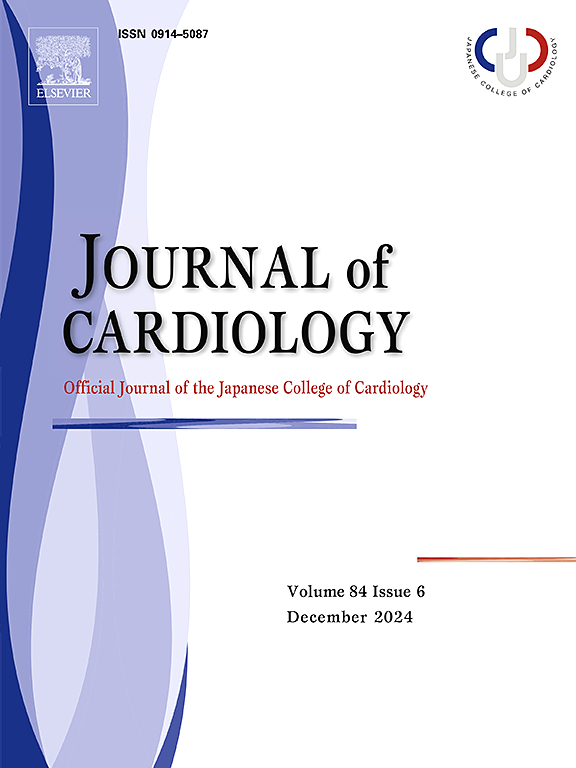Effect of cardiac rehabilitation on progression to long-term care: A clinical and economic longitudinal study in Japan
IF 2.5
3区 医学
Q2 CARDIAC & CARDIOVASCULAR SYSTEMS
引用次数: 0
Abstract
Background
The social burden of nursing care is increasing with age, particularly for patients with heart failure who often require intensive care. This study aimed to clarify the relationship between nursing care needs and the clinical status of patients with a history of cardiovascular disease, focusing on the benefits of cardiac rehabilitation (CR) in reducing these needs.
Methods
This single-gate, multicenter, retrospective observational study included patients of all ages with a history of hospitalization for cardiovascular diseases using government-administered insurance claims and health examination data. Data spanning a four-year period (April 2014 to March 2018) were analyzed, and the effects of CR on nursing care needs and associated factors were examined. Multivariate analysis and propensity score matching were used to adjust for confounding factors, ensuring a robust comparison between CR and non-CR groups.
Results
A total of 48,456 patients were enrolled, with an average follow-up of 36.1 months. After propensity score matching, patients who participated in CR demonstrated significantly lower mortality rates and reduced nursing care needs compared to those who did not (0.02 ± 0.13 vs. 0.04 ± 0.20, p < 0.01, 0.94 ± 0.27 vs. base: 1, p = 0.05). CR was associated with improved adherence to medications and increased generic drug prescriptions, contributing to better long-term health outcomes. The adjusted odds ratio for CR in reducing nursing care needs was 0.574 (95 % CI, 0.347–0.948, p < 0.05).
Conclusions
This study confirms the potential critical role of CR in reducing mortality and nursing care needs in patients with cardiovascular disease. Although CR did not directly reduce nursing care costs, it contributed to improved health outcomes and reduced dependency on long-term care services. These findings highlight the benefits of CR as a preventive intervention, especially in aging populations. Further research is needed regarding its long-term economic benefits.

心脏康复对长期护理进展的影响:日本的临床和经济纵向研究。
背景:护理的社会负担随着年龄的增长而增加,特别是对于经常需要重症监护的心力衰竭患者。本研究旨在阐明有心血管病史患者的护理需求与临床状况之间的关系,重点研究心脏康复(CR)在减少这些需求方面的益处。方法:这项单门、多中心、回顾性观察性研究纳入了所有年龄、有心血管疾病住院史的患者,使用政府管理的保险索赔和健康检查数据。对2014年4月至2018年3月的4年数据进行分析,探讨CR对护理需求及相关因素的影响。使用多变量分析和倾向评分匹配来调整混杂因素,确保CR组和非CR组之间的可靠比较。结果:共纳入48456例患者,平均随访36.1 个月。倾向评分匹配后,与未参加CR的患者相比,参加CR的患者死亡率和护理需求明显降低(0.02 ± 0.13 vs. 0.04 ± 0.20,p )。结论:本研究证实了CR在降低心血管疾病患者死亡率和护理需求方面的潜在关键作用。虽然CR没有直接降低护理成本,但它有助于改善健康结果,减少对长期护理服务的依赖。这些发现强调了CR作为一种预防性干预措施的益处,特别是在老龄化人群中。其长期经济效益有待进一步研究。
本文章由计算机程序翻译,如有差异,请以英文原文为准。
求助全文
约1分钟内获得全文
求助全文
来源期刊

Journal of cardiology
CARDIAC & CARDIOVASCULAR SYSTEMS-
CiteScore
4.90
自引率
8.00%
发文量
202
审稿时长
29 days
期刊介绍:
The official journal of the Japanese College of Cardiology is an international, English language, peer-reviewed journal publishing the latest findings in cardiovascular medicine. Journal of Cardiology (JC) aims to publish the highest-quality material covering original basic and clinical research on all aspects of cardiovascular disease. Topics covered include ischemic heart disease, cardiomyopathy, valvular heart disease, vascular disease, hypertension, arrhythmia, congenital heart disease, pharmacological and non-pharmacological treatment, new diagnostic techniques, and cardiovascular imaging. JC also publishes a selection of review articles, clinical trials, short communications, and important messages and letters to the editor.
 求助内容:
求助内容: 应助结果提醒方式:
应助结果提醒方式:


